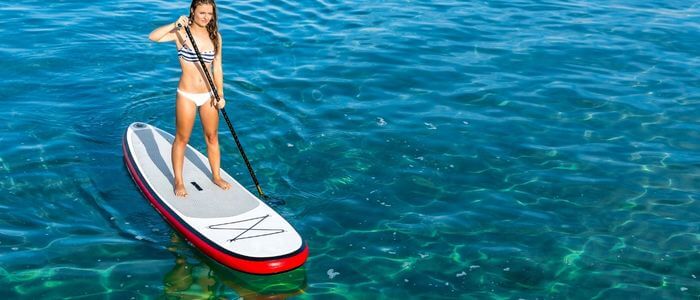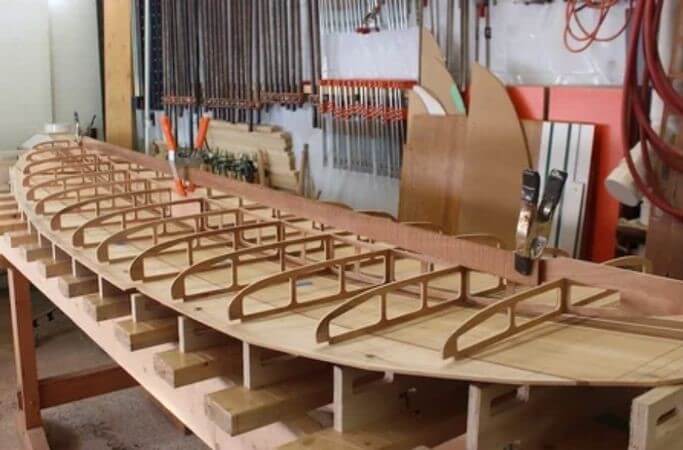
Have you been thinking about paddle boards lately and why they’re so expensive? After all, they’re just wooden planks on which you can float above the water.
This simple question comes into almost every beginner paddle boarder’s mind. So, here I’m going to tell you why paddle boards are so expensive.
So, let’s get started.

There are lots of reasons why paddle boards are so expensive. Here I’m going to discuss some of them.
So many different materials are used to make a paddle board that it’s hard to keep track. The most common ones include wood, fiberglass, plastic, carbon fiber, and epoxy. Most boards use some combination of these materials to create their final product.
The cost difference comes down to how much labor went into making each board—and how many people worked on them!
Paddle boards are wood, fiberglass, plastic, carbon fiber, and epoxy. And the more expensive ones use a combination of those materials. The difference in cost between boards comes down to the materials they use and the labor that goes into making them.
As you can probably guess, the difference between just two boards could run as high as thousands or even tens of thousands, depending on who made them and how they were made!

And companies can’t afford to sell their boards at a low price. And since most of us don’t have thousands of dollars to spend on a paddle board, we often turn to cheaper brands. But there are some things you should know about the production costs of paddle boards.
The upfront cost of a paddle board is expensive because it costs a lot to make one in the first place. It’s also time-consuming, so as you pay for craftsmanship, you’re also paying for time.
As you can see, a paddle board is not just a board. It’s also an investment in time and materials that take months and years to create.
Building a quality paddle board will require many different steps, each one taking its amount of time. For example:
This all adds up pretty quickly! So when I say they are expensive because they cost so much money and time to build, I mean it!
You may be wondering why paddleboards are so expensive. Well, it’s not just about the materials and manufacturing processes—it’s about the people who make them.
Craftsmanship is important to any product or service that you purchase, but when it comes to paddleboards, this craftsmanship takes on a whole new meaning. Each board is made by hand by one person at the time of order (or sometimes even later).
It also means that there isn’t some assembly line where workers stamp out identical versions every day like there would be if they were mass produced in China or India. Instead, they are made specifically for you and your needs. You can have a custom board made for you or choose from one of their existing models that are ready to go!
Many paddleboard makers get into the business because they love making boards with their own hands, and they’re not always trying to make money off them. They do it because they want to share their passion with others, and though their prices may be high, paddle boards are amazing pieces of artwork.
Distribution is difficult because there are no large distributors of paddle boards in the United States. The production of paddle boards is small, so getting them out there and into the hands of people who want them can be tough. The distribution of a product is difficult; there are usually two ways to get around it: find a distributor or make your own.
Finding a distributor takes time, which means the company will have to wait for its money until they sell enough products before they see any profits. The problem with making your own is that it takes time and money—and if you don’t do things right, you could end up wasting both resources that you had set aside for something else entirely.
That is why paddleboards are expensive —not because of their materials, but because the company that makes them has to ensure they are distributed properly. They don’t want to lose money by selling something that doesn’t sell well, so they charge more than what it would cost if you bought the materials and made your paddleboard.
The best way to determine the size of a paddleboard is by measuring yourself and comparing those measurements to the dimensions on each brand’s website. You’ll also want to consider how often you plan on using it, whether you’ll be carrying passengers or not, and where your ideal spot for paddling is located—all of these things can impact how much space you need to be while riding around.
The answer to this question is not always straightforward. In some cases, an expensive paddleboard may be better than an inexpensive one; however, there are also many instances where the opposite is true.
For example, an inexpensive model might be exactly what you need if you’re simply for something that can get you around on the water without breaking too much of a sweat or straining your wallet. If you want to take on more challenging waters and need something that will help keep you afloat in choppy waves, it will probably benefit you to invest in a pricier paddleboard instead.
Paddleboards are a great way to spend time on the water, but it’s choosing one that’s right for you is important are some features to look for in a paddleboard:
Length: The length of the paddleboard should be based on your height and build. For example, if you’re 5’6″, look for a board that is between 70 and 80 inches long. If you’re 5’10”, look for one that is 75 to 90 inches long. The length also affects how stable the board feels while standing on it.
Width: The whiteboard’s width depends on your height and build. If you’re shorter than most people, choose a wider board so it will feel more stable when standing on it. If you’re taller than most people, look for a narrower board so it will feel more comfortable when sitting down on it.
Material: The material used when making your paddleboard can affect how well it holds up over time and how well it performs in different conditions (such as wind or waves). Wood is generally considered more durable than fiberglass or Kevlar, but fiberglass is typically lighter weight and easier to repair if damaged during use—so it’s a good choice if you plan to use your board in different types of water.
So by going through the above reasons, understand why paddleboards are so expensive. Paddleboards are a high-performance item, and they’re made to last. If you plan on using your board often and over many years, the investment will be worth it—but if you’re looking for something fun to do once in a while, you can probably find a cheaper option that still gets the job done.

Hey there kayak lovers! I’m Jay Schwartz, the author here at Kayak Guidance! You know water sports – you know me! My life is all about it. Kayaking, Paddleboarding, Fishing, Snorkeling and so much more. I love to share my passion and knowledge with all of you.

Hey there kayak lovers! I’m Jay Schwartz, the author here at Kayak Guidance! You know water sports – you know me! My life is all about it. Kayaking, Paddleboarding, Fishing, Snorkeling and so much more. I love to share my passion and knowledge with all of you.

Welcome to KayakGuidance.com! If you’re looking to have some fun outdoor water adventures, then you have come to the right place. We help our readers find the best kayaks and water related equipment to help you have the best time of your life whenever you are engaging in water activities.
This site is a participant in the Amazon services LLC associates program, an affiliate advertising program designed to provide a means for sites to earn advertising fees by advertising and linking to Amazon.com.